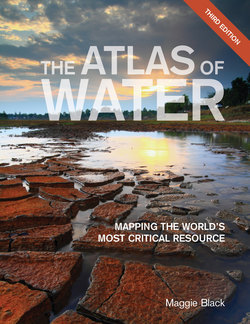Читать книгу The Atlas of Water - Maggie Black - Страница 11
На сайте Литреса книга снята с продажи.
Оглавлениеper capita a day. Everything that is manufactured – from electronic equipment to newspapers and kitchen gadgets – has involved water in its production. The total amount of water each person consumes if such products are factored into our “water footprint” is far higher than the figure for direct consumption. Nor is usage restricted to water from local sources: it also includes water embedded in food and goods imported from elsewhere. Thus water-stressed areas in Africa, America, Asia and Australia may be used to produce consumer items for export, while – with real injustice – local farmers and herders go short. Pollution At the same time as demand on volumes increase, pressures mount on freshwater quality. No longer can natural water from springs, dug wells and running rivers automatically be assumed to be clean and safe to drink. The natural capacity of waterways to act as the world’s inbuilt dish-washing apparatus is inadequate to cope with the overload of wastes from increased population density. Many towns and cities in the developing world suffer the indignity of London 150 years ago when, in a hot summer season, the Thames was reduced to a Great Stink by a combination of upstream take-off and raw sewage inflows. Around 90 percent of human waste in the developing world is still discharged untreated into rivers. Since the threat of a cholera epidemic by the intake of foul air no longer causes the alarm it once did, the public-health incentive for dealing with this nuisance is not what it used to be. An overload of human waste in rivers, lakes and streams destroys plant and aquatic life and can carry with it bacteria and viruses that cause serious diseases. The pollution caused by chemical wastes and industrial spills may not be as visible, but may be even more damaging. Where pesticide residues and pharmaceutical ingredients are washed into rivers or leached into the soil and from there enter the food chain, their toxic effects may build up in human tissues and cause long-term ill-health. Some pollutants may be traced thousands of miles from where they were originally discharged. For too long, the world’s freshwater and seawater network has been considered as having an unlimited capacity to function as humanity’s sink. As a result, many parts of the network have become degraded. Co-operation over water The increasing pressure on water resources has led to intense competition. Within one community, it is often hard to agree who has the right to take freely from the source for irrigation purposes, or whether people with a tap in their yard should pay a higher rate than those still obliged to walk to the pump. Should fines be imposed on people whose tannery, or cloth-dying business, or latrine has fouled the local source? These are questions that have exercised communities for centuries. At the local level, water governance has always demanded
12
